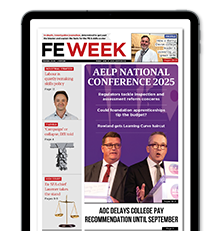More than two in five apprentices on standards failed to successfully complete their qualification last year.
National achievement rate tables (NARTs) published this morning by the Department for Education show that the overall rate for all apprenticeships fell from 64.8 per cent in 2018/19 to 64.2 per cent in 2019/20.
The data shows that apprentices on old-style frameworks, which are being phased out, hit a 67.8 per cent achievement rate, but the new-style standards only achieved 58.7 per cent.
This is, however, an almost 12 percentage point increase on 2018/19 when just 46.9 per cent of apprentices on standards achieved.
The retention rate for standards continues to be low, sitting at 60.2 per cent.
Commentary published by the DfE alongside the statistics claims that a difference in apprenticeship achievement rates between framework and standards is “not, at least initially, an entirely unexpected consequence of our reforms”.
“Whilst some standards do have similar names to frameworks, standards are not designed to be a direct replacement for frameworks and as such, they should not be directly compared,” the document said.
“Department for Education reforms changed what an apprenticeship is: standards are longer, with more training and an independent end-point assessment to test occupational competency at the end. End-point assessment is a new assessment method, making achievements on standards more demanding and this could also impact the qualification achievement rate.”
Breaking the data down by subject area, it shows that agriculture, horticulture and animal care had the lowest achievement rate at 50.9 per cent, followed by construction at 52.3 per cent, and then leisure, travel and tourism at 55.6 per cent.

While the DfE has released achievement rate data at a national level for 2019/20, they have not published it at individual provider level or by institution type this year due to the pandemic.
The data will also not be used by bodies such as Ofsted, local authorities or devolved authorities or within ESFA, to hold providers to account.
The DfE commentary warned that “care should be taken when comparing outcomes with previous years due to the effects of the pandemic”.
“A number of things will have impacted these data. For example there was an increase in the number of breaks in learning for those with 2019/20 expected end dates in which we can observe a large number of outcomes being delayed until 2020/21,” it added.
Responding to today’s figures, a DfE spokesperson said: “Our reforms to apprenticeships have made them longer and better, with more off-the-job training and a proper assessment at the end. As more and more apprentices are on the new, more rigorous standards, we are pleased to see that the achievement rate for apprenticeship standards has increased by 11.8 percentage points from 2018/19 to 2019/20.
“The recently published FE White Paper outlined the steps we are taking to ensure every apprentice has a high quality experience, including investing in a comprehensive package of professional development available to all apprenticeship providers and their workforce.”









Although it should be the aim of every provider and college to get to an 80% achievement rate this set of figures are not as bad as they are being painted. Standards-based apprenticeships can have an awful lot more related theory to be taught and tested on, and rather than the continuous assessment of frameworks apprentices have to demonstrate what they can do in an end point assessment. The very nature of those delivering the apprenticeships has completely changed from assessors to ‘teachers’. I can well remember going through the findings of an apprenticeship survey with a chief inspector who was very dismissive of the national success rates at the time when I pointed out the national school picture at the time for 5 GCSE grades at C and above including maths and English was around the 53% mark, and guess what many of the unsuccessful 47% would be doing, yes, apprenticeships. Amazing then considering their national statistics how many schools get outstanding as a judgement from Ofsted? We need to have normality back before we can make judgements on apprenticeships that are truly valid, but I do know that the practical skills levels being achieved are improving from working with ITPs and colleges over the last few transformational years.
The DfE commentary suggests that part of the reduction in success rates is due to EPA, but the statistics show that EPA pass rates are extremely high. So what is happening here? Traditionally the provider has been held solely responsible for success rates, but an examination of leave reasons suggests that in the last year more apprentices are withdrawing from programme for employment-focused reasons such as redundancy.